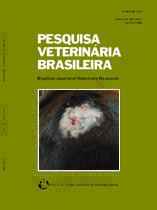 |
|
|
|
Year 2017 - Volume 37, Number 3
|

|
Isolation and determination of antimicrobials sensitivity and resistance of bacterial strains present in the cloaca Trachemys scripta elegans (Wied, 1839) raised in captivity in Petrolina/PE, Brazil, 37(3):261-268
|
ABSTRACT.- Silva Sobrinho F.B., Sá M.C.A., Gouveia G.V., Costa M.M., Faria M.D., Milanelo L. & Gradela A. 2017. [Isolation and determination of antimicrobials sensitivity and resistance of bacterial strains present in the cloaca Trachemys scripta elegans (Wied, 1839) raised in captivity in Petrolina/PE, Brazil.] Isolamento e determinação de sensibilidade e resistência a antimicrobianos de cepas bacterianas presentes na cloaca de Trachemys scripta elegans (Wied,1839) criadas em cativeiro em Petrolina, PE. Pesquisa Veterinária Brasileira 37(3):261-268. Colegiado de Medicina Veterinária, Universidade Federal do Vale do São Francisco, Rodovia 407 Km 12, Lote 543, Projeto Nilo Coelho C1, Petrolina, PE 56300-000, Brazil. E-mail: agradela@hotmail.com
This study isolated and determined the profile of susceptibility and antimicrobials resistance of bacterial strains isolated from the cloaca Trachemys scripta elegans (T. s. elegans) raised in captivity. After 120 days of adaptation, cloacal swab samples obtained from 20 adults animals were grown and, after the pathogens identification through biochemical tests, submitted to the test of susceptibility to nine antimicrobials. Enterobacter aerogenes (85%); Shigella spp. (10%) and Edwadsiella spp. (5%) were isolated and identified. Isolates from E. aerogenes were sensitive to gentamicin (86%), enrofloxacin (79%), streptomycin (50%), sulfazotrim (36%) and ampicillin (29%) and resistant to penicillin (100%), erythromycin (93%), cephalexin (86%), ampicillin (71%) and sulfazotrim (64%). Isolates from Shigella spp. showed sensitivity to gentamicin (100%), enrofloxacin (50%), doxycycline (50%), streptomycin (50%), ampicillin (50%), penicillin (50%) and sulfazotrim (50%) and resistance to doxycycline (50 %), streptomycin (50%), ampicillin (50%), penicillin (100%), cephalexin (50%) and sulfazotrim (50%), while the Edwardsiella spp. were sensitive only to gentamicin (100%) and were highly resistant (100%) to other antibiotics. The results suggest the participation of T. s. elegans in the epidemiological chain, as reservoir of important pathogens, such as E. aerogenes, Shigella spp. and Edwardisiella spp., making it important to adopt preventive measures for zoonotic risk that present and correct treatment and control in captivity and households, as well as studies that address the sensitivity characteristics and antimicrobial resistance of isolates from cloaca, as it multidrug resistance to drugs can be transmitted to humans and compromise the treatment of patients with serious diseases. |
| |
|
|
| |
|
 |